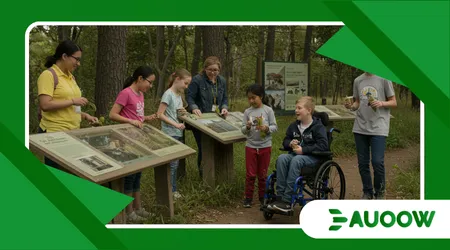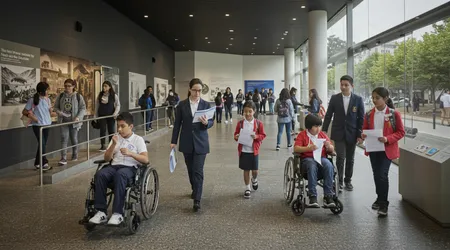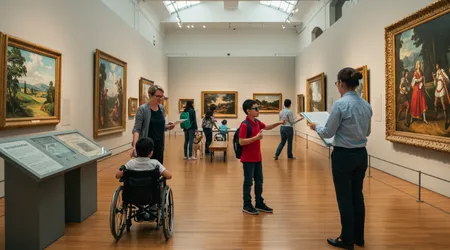How to Make School Field Trips Accessible for All Students

Ensuring to make school field trips accessible starts with intentional planning that prioritizes every student’s needs.
Field trips spark curiosity, deepen learning, and build community, yet barriers like mobility limitations, sensory challenges, or financial constraints can exclude some students.
In 2025, inclusive education demands creative, equitable solutions to ensure every child can participate fully.
This article explores practical, innovative strategies to remove obstacles, drawing from real-world examples and grounded in the principles of Universal Design for Learning (UDL).
By rethinking logistics, communication, and engagement, educators can craft experiences that leave no one behind. Why should any student miss out on the joy of discovery?
Understanding Accessibility in Field Trips
Accessibility in field trips goes beyond physical accommodations. It encompasses sensory, cognitive, and financial inclusivity, ensuring all students engage meaningfully.
A 2023 study by the National Center for Learning Disabilities found that 1 in 5 students has a disability affecting their educational experience.
Schools must address diverse needs, from wheelchair access to sensory-friendly environments. For instance, a student with autism might need noise-canceling headphones, while another with visual impairments requires audio descriptions.
Financial barriers also matter some families can’t afford trip fees. Inclusive planning starts with understanding these varied challenges and proactively addressing them.
Field trips are more than outings; they’re extensions of the classroom. Every student deserves to participate in these enriching experiences.
Consider a museum visit: a child with motor difficulties might struggle with stairs, while another with ADHD could feel overwhelmed by crowds.
++ Creating Inclusive School Events: Practical Guidelines
Schools must anticipate such challenges before selecting destinations. Engaging families early helps identify specific needs, fostering trust.
By prioritizing inclusivity, educators signal that every student’s learning matters, creating a sense of belonging that resonates beyond the trip itself.
Proactive communication with students and parents is key. Surveys or pre-trip meetings can reveal individual needs, like dietary restrictions or medical requirements.
For example, a school in Seattle used parent input to choose a zoo with sensory-friendly hours, ensuring a calmer experience for neurodivergent students.
This approach builds community and empowers families to advocate for their children. Accessibility isn’t an afterthought it’s the foundation of equitable education.

Choosing Inclusive Destinations
Selecting the right destination is critical to make school field trips accessible. Venues must offer physical, sensory, and cognitive accommodations to suit diverse learners.
For example, the Smithsonian’s accessibility programs include tactile tours and sign-language interpreters, ideal for students with sensory impairments.
Schools should research venues with ramps, elevators, and quiet spaces. Outdoor locations, like nature reserves, need clear paths for wheelchairs. Choosing inclusive sites ensures every student can explore without barriers.
Beyond physical access, consider the sensory environment. A bustling amusement park might overwhelm students with sensory processing issues.
Also read: Teaching Literacy to Students with Learning Disabilities: Modern Approaches
Instead, opt for places like botanical gardens with quiet zones. For instance, a Chicago school chose a planetarium with sensory-friendly shows, allowing students with autism to enjoy the experience comfortably.
Verify venue accessibility through site visits or online resources before committing. This diligence prevents last-minute exclusions and sets the stage for success.
Engage venue staff early to customize the experience. Many museums now offer pre-visit virtual tours, helping students with anxiety prepare.
A school in Austin partnered with a local farm to create a tailored tour for visually impaired students, incorporating touch-based activities like feeling animal fur.
These collaborations show venues care about inclusivity, encouraging schools to advocate for accommodations. Choosing the right destination is like laying a strong foundation build it thoughtfully, and everyone thrives.
Planning Logistics with Equity in Mind
Logistics can make or break accessibility. Transportation, scheduling, and funding must align to make school field trips accessible for all.
Buses with wheelchair lifts are non-negotiable for students with mobility challenges. Schools should confirm vehicle accessibility with providers well in advance.
For example, a New York district partnered with a transit company to secure low-floor buses, ensuring all students could board easily. Timing matters too avoid peak hours to reduce sensory overload for neurodivergent students.
Funding trips equitably is critical. In 2025, rising costs exacerbate financial barriers for families. Schools can seek grants or PTA support to cover fees, ensuring no student is left behind due to cost.
A California school crowdfunded a trip to a science center, raising enough to include all students, regardless of family income. Transparent budgeting builds trust and shows commitment to equity. No child should miss a trip because of money.
Read more: The Best Classroom Layouts for Inclusive Learning
Clear schedules enhance accessibility. Provide detailed itineraries with breaks for students needing rest or sensory regulation.
A Florida school created a visual timetable with icons for a zoo trip, helping students with cognitive disabilities navigate the day.
Assign support staff to assist students with specific needs, like a paraprofessional guiding a visually impaired student. Thoughtful logistics turn potential chaos into a seamless, inclusive experience.
Engaging All Learners During the Trip
Active engagement ensures to make school field trips accessible isn’t just about getting there it’s about meaningful participation.
Tailor activities to diverse learning styles using UDL principles. For example, a history museum trip could include tactile exhibits for visually impaired students and audio guides for auditory learners.
A Boston school used interactive scavenger hunts with picture-based clues, engaging students with intellectual disabilities. Activities should spark curiosity while respecting individual needs.
Sensory considerations are vital. Provide tools like noise-canceling headphones or fidget toys for students with sensory sensitivities.
A Denver school brought weighted blankets to a theater trip, calming students with anxiety. Train staff to recognize signs of distress and offer support discreetly.
Engagement thrives when students feel safe and included, allowing them to focus on learning rather than discomfort.
Incorporate student choice to boost engagement. Let students select from activities like sketching, journaling, or group discussions.
A Texas school’s aquarium trip offered options: students could draw sea creatures, listen to a guided tour, or join a Q&A.
This flexibility empowered students with different abilities to participate fully. Engagement is like a spark ignite it with options, and every student shines.
Post-Trip Reflection and Inclusion
Reflection cements learning and ensures to make school field trips accessible extends beyond the event. Create multiple ways for students to share experiences, accommodating diverse abilities.
Verbal discussions suit auditory learners, while drawing or writing works for others. A Seattle school used a digital platform where students posted photos or voice memos about a zoo trip, including those with communication challenges. Reflection fosters inclusivity by valuing every voice.
Follow-up activities reinforce learning. Assign projects like creating a group mural or presenting findings to peers.
A Chicago school had students with mobility impairments lead a virtual presentation about a park visit, boosting confidence.
Involve families by sharing trip highlights via newsletters or parent portals. This inclusion strengthens community ties and shows the trip’s impact.
Address feedback to improve future trips. Collect input from students, parents, and staff through surveys or focus groups.
A New Jersey school learned from feedback that sensory breaks were insufficient, prompting better planning for the next trip.
Continuous improvement ensures accessibility evolves with student needs. Reflection isn’t just closure it’s a bridge to better experiences.
Leveraging Technology for Accessibility

Technology can transform field trips into inclusive adventures. Tools like virtual reality (VR) or augmented reality (AR) allow students unable to travel to participate.
A 2024 EdTech report noted 68% of schools using VR for inclusive learning experiences. A Michigan school used VR headsets to simulate a museum tour for homebound students, ensuring they didn’t miss out. Tech bridges gaps when physical attendance isn’t possible.
On-site, apps like audio guides or real-time captioning aid students with hearing or visual impairments. For example, a London museum’s app provides sign-language videos, enhancing access for deaf students.
Schools should test these tools pre-trip to ensure compatibility. Technology isn’t a cure-all, but it’s a powerful ally in making experiences inclusive.
Train teachers to use tech effectively. A California district held workshops on accessible apps, empowering educators to support students during a science center trip.
Pair tech with human support devices can’t replace empathy. Like a trusty guide, technology enhances the journey when used thoughtfully, ensuring to make school field trips accessible for all.
Table: Accessibility Checklist for Field Trips
| Aspect | Action | Example |
|---|---|---|
| Destination | Verify ramps, elevators, sensory-friendly options | Choose a museum with tactile tours |
| Transportation | Use buses with wheelchair lifts, confirm accessibility | Partner with a provider for low-floor buses |
| Funding | Secure grants, crowdfund, or offer scholarships | Crowdfund for a science center trip |
| Engagement | Provide sensory tools, offer activity choices | Use noise-canceling headphones, scavenger hunts |
| Technology | Incorporate VR, audio guides, or captioning apps | Use VR for homebound students |
| Reflection | Offer multiple formats (drawing, verbal, digital) for sharing experiences | Create a digital platform for post-trip posts |
This comprehensive approach to to make school field trips accessible blends empathy, planning, and innovation.
By prioritizing diverse needs, schools create equitable, enriching experiences that resonate with every student.
From choosing inclusive venues to leveraging technology and fostering reflection, each step builds a culture of belonging.
Accessibility isn’t a checkbox it’s a commitment to ensuring every child’s curiosity is nurtured. Let’s make field trips a journey where no one is left behind.
Frequently Asked Questions
Q: How can schools afford accessible field trips?
A: Seek grants, partner with PTAs, or crowdfund. Transparency about costs builds trust and ensures no student is excluded due to finances.
Q: What if a venue lacks accessibility features?
A: Collaborate with staff to create solutions, like virtual tours or modified activities. Advocate for improvements to benefit future visits.
Q: How do sensory-friendly trips work?
A: Choose venues with quiet zones or sensory-friendly hours. Provide tools like headphones and train staff to support students’ sensory needs.
